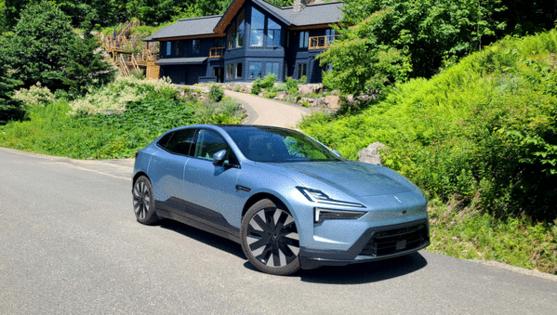Auto review: No window, no problem. Chasing Tesla in the sleek Polestar 4
Published in Automotive News
MONTREAL — On two-lane Route 117 in Quebec, I jumped into the left lane, nailed the throttle in my 544-horsepower, 2026 Polestar 4 and — ZOT! — was past the truck in front of me in the blink of an eye. I glanced in the rear camera mirror, pulled back into the right lane, and gave the truck a wave.
Except the Polestar 4 has no rear window, and the trucker never saw my gesture. Haw.
Polestar’s latest compact SUV is quick, cool and — as its clever rear design implies — innovative; just like Tesla models that pioneered the EV segment over the last dozen years. With Tesla in mind, Volvo (and its Chinese owners) spun off its Polestar performance badge in 2017 as a full-line electric vehicle brand. Where Volvo has developed EVs with its safety and design north stars, Polestar has leaned into speed and innovation.
The fourth — and most important model to date in Polestar’s young journey — the 4 is a Scandinavian Tesla Model Y. Call it Polesla.
Like the camera mirror in Tesla’s Cybertruck, the 4’s rearview unit is necessitated by its radical rear roof design. Determined to make the compact SUV look like a racy sports coupe (while maintaining utilitarian rear seat and cargo space), the Polestar 4 does without a rear window, confident that the advance of digital mirrors and blind-spot assist would cover the void.
It works, though old habits (like my trucker wave) will die hard.
It’s a reminder that digital technology is changing every tool in the automobile. Cadillac innovated the camera mirror last decade. At the Detroit Grand Prix in 2018, I asked race car driver Jorden Taylor what his 600-horsepower, $730,000 winged Cadillac DPi.V.R cyborg shared with a production Cadillac.
“Two things,” said the affable race pilot. “The V-8 engine block and the camera mirror. You can’t see out of these mid-engine race cars, and the camera mirror allows me an unobstructed view out back to I can see my competitors and slower traffic around me. I love it.”
Now it’s standard in the $57,400 Polestar 4. It will not be to everyone’s liking in a ferociously competitive premium class that includes Model Y, Cadillac Optiq, Mustang Mach-E, Genesis GV70, BMW iX3 and Lexus RZ. All with rear windows.
What won’t be polarizing is the Polestar’s rear head and legroom. At a charging station (more on that later), I hopped into the back seat, where the standard panoramic roof arched backward above me. It easily cleared my 6’5” head before plunging into the rear tailgate, much further rearward than other roofs in the segment. The result is plenty of light for the rear passenger. Sun too strong? Opt for the cool two-mode roof that will turn opaque at a touch of a button.
I could also move the rear seat back, comfortably stretching my legs to sit behind myself. Still, competitors like Tesla and Optiq offer more room.
Like its peer internal combustion engine segment, compact EV SUVs are where the sales are, and brands have brought their A game.
The Model Y is so good it was the second best selling non-pickup in the market last year after the gas-powered mainstream Toyota RAV4 compact SUV. The Polestar follows the formula with distinctive styling, a simple interior and raw speed.
South Korea-made and Chinese-owned (Geely), the 4 is the third mass production model in the Polestar lineup, following the (now withdrawn) 2 hatchback and 3 midsize SUV. The 4 (Polestar numbers its vehicles in order of rollout) has matured with its own design cues.
Gone are the Volvo-like Thor’s Hammer headlights in the 2 and 3, replaced by dual-blade headlights, grille-less sports car fascia and horizontal tail lamps. The separation from Volvo is important, even as Polestar stays true to spare Scandinavian style prized by everyone from Ikea furniture to Orrefors glass shoppers.
The 4’s exterior is cleaner than the busier lines of the 2 and 3. With its wide stance, coupe roofline and deeply-scalloped rocker panels, the SUV gives off a sporty, athletic vibe.
The simplicity continues inside. With key in pocket, the 4 recognized me as I approached, extending the flush door handles like a handshake. When I settled into the comfortable high-backed seats, the Polestar automatically turned on. No need to touch the brake pedal, push a button, insert a key. Slick.
As was the spare interior anchored by a 15.4-inch horizontal screen. No buttons cluttered the dash or doors. Tesla-like, I adjusted my side mirrors, steering wheel and air vents in the screen. Operated by Google Built-in (like General Motors EVs), other functions can be controlled by voice command.
Hey, Google, set driver temperature to 70 degrees.
Done.
Hey, Google, navigate to Mont-Tremblant, Quebec.
Done.
Hey, Google, make the roof opaque.
Done.
Hey, Google, tell me a joke.
“How do trees access the Internet? They log in.”
I like a car with personality, and the 4 has it in droves. Tesla has fart cushions, tracks Mars, and names its drive modes (like Plaid) after the movie “Spaceballs.” Polestar tells jokes, tracks the solar system and weaves its interior fabrics like Swedish textiles.
It tracks Tesla on charging, too, with NACS (North American Charging Standard) connector so you can navigate to — and fill up at — Tesla’s ubiquitous Supercharger network.
The 4 trails the segment’s best EVs, the Model Y and Optiq, in two respects.
First, while my $64,300 all-wheel-drive tester boasts eye-popping acceleration numbers on par with a Model Y Performance, the Polestar is a significant 800 pounds porkier and a big financial ask (especially with the $7,500 federal welfare gone) for a new luxury badge.
Second, while the equally luxurious Optiq is also porky, both the Cadillac and the Tesla offer superior hands-free driving systems. Navigate from, say, Montreal to Detroit, and the Tesla (and Caddy) will take you there hands-free on four lanes. Not the 4, which only sports adaptive cruise control.
Still, it’s great to see a new badge mature, and the Polestar 4 is a welcome addition to the U.S. market. Just remember to roll down your window if you want to wave at the trucker you just blew by.
2026 Polestar 4
Vehicle type: All-wheel-drive, five-passenger compact SUV
Price: Base $57,400, including $1,400 destination charge ($64,300 Dual Motor as tested)
Powerplant: Lithium-ion battery pack mated to single/dual electric motors
Power: 272 horsepower, 253 pound-feet torque (single rear motor); 544 horsepower, 506 pound-feet torque (dual front and rear motors)
Transmission: Single-speed automatic
Performance: 0-60 mph, 3.7 seconds (mfr.); top speed, 124 mph
Weight: 5,192 pounds (as tested)
Range: 310 miles (single motor), 280 miles (dual front and rear motors)
Report card
Highs: Cool design; electric performance
Lows: Polarizing design; lacks full self-drive
Overall: 3 stars
____
©2025 www.detroitnews.com. Visit at detroitnews.com. Distributed by Tribune Content Agency, LLC.








Comments